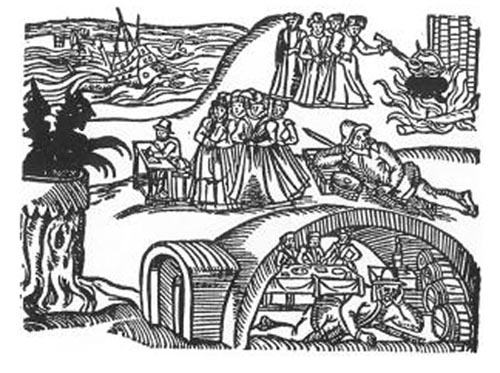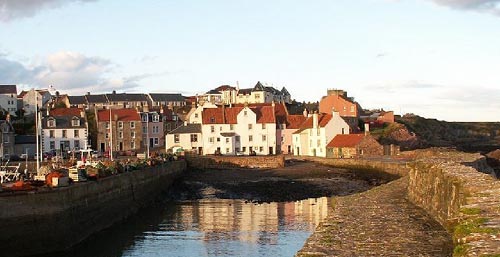A SCOTTISH village is set to create the country’s first official memorial to witches who were tortured and killed by vengeful mobs.
The 1,600 citizens of Pittenweem, Fife, are taking part in a controversial “referendum” on whether they want a memorial and where it should be.
At least 26 “witches” were tortured and 18 of them killed in the picturesque fishing village in the early 18th Century.
The local community council has written to every adult in the community asking if they agreed in principle with the plan.
If they are given the green light, a permanent memorial will be constructed in the village, most likely on the site of the most notorious witch killing, that of Janet Cornfoot.
Sir Sean Connery’s ancestors were reportedly among the lynch mob that tortured and killed her in 1705.
After she was accused of witchcraft, Cornfoot was swung from a rope, stoned, and then crushed under a heavy door piled high with boulders.
To make quite certain she was dead, a horse and cart was repeatedly driven over her body and her remains buried in an area called West Braes.
Local historian, Leonard Low , author of ‘The Weem Witch’, said of the referendum: “It is just fantastic and a massive step forward. This will be the first time in Britain that such a memorial has been erected.”
Low, whose family have lived for generations in Pittenweem, spearheaded the campaign to commemorate the witches.
He added: “I was looking at the names of people who lived in Pittenweem during these events. One of the families are the distant ancestors of Sean Connery.
“The interesting thing is that the records state that everyone in the village took part in this horrific murder, so I think his ancestors would have been involved and very much a part of that mob.”
Louise Park, presiding officer for the Pagen Federation of Scotland, said the monument would be a fitting way to remember those who had lost their lives.
She said: “A memorial would be a great thing to remember the people who were victims of hunts and persecutions. It is always good to remember that people can be persecuted by people in authority.”
One proposed design for the memorial at West Brae is a tall metal structure depicting the door used to crush Cornfoot, emblazoned with the names of all 26 victims. Hands will grip the door on either side, a powerful reminder of the mob who took her life.
Margaret Laidlaw, a member of the community council, confirmed: “A questionnaire has gone out and we are waiting to hear local opinion on the matter before we thrash out the finer details.”
During the witch trials at Pittenweem, sixteen of the accused were burnt at the stake, and one died during torture.
Despite the horrors and the abuses or power, not everyone agrees with the memorial plan.
The community council’s own acting secretary, David Birrell, described it as “ridiculous”.
The community council’s own acting secretary, David Birrell, described it as “ridiculous”.
“I know all this is going on and I can hardly believe it,” he said. “It is completely ridiculous. This all happened 300 years. To put a monument in Pittenweem for something that happened so long ago is beyond belief.”
Dr Peter Maxwell-Stuart, a history lecturer at the nearby University of St.Andrews, said the monument would be “futile”.
He said: “Apologising for what your ancestors have done in the past is futile. It is making an assumption that all these people were innocent when of course they weren’t. Practising witchcraft was against the law at the time and was considered a criminal offence and to apologise would be a mistaken view of history.
“If I was given a vote in Pittenweem I would certainly vote against the memorial,” he added.
Much of the abuse in Pittenweem was the result of local minister Patrick Cowper’s determination to ignore the laws of the day.
The authorities in Edinburgh demanded evidence that witches had used their supernatural powers in the commission of actual crimes such as murder. And even, they had to give their permission for a trial to go ahead.
Cowper imprisoned women merely on flimsy accusations of practising witchcraft. And he incited the mob to mete out its murderous brand of justice before getting permission from Edinburgh.
When the national government ordered a stop to the persecution, the few surviving women were released and the folk of Pittenweem turned against Cowper. In yet another bizarre twist, they imprisoned his cow in the same jail that had been used for the witches.
Cowper was never brought to justice although his gravestone in the village was vandalised to the point where the inscription can no longer be read.
The cost of the memorial, and who would pay for it, has still be worked out.
Alan Paul, Fife Council’s Corporate Asset Manager said the long-term maintenance of the memorial would have to be carefully planned.
He said: “It’s not just a question of building something, but also ensuring that it can be maintained in good order for the long-term.”
Short URL: http://www.deadlinenews.co.uk/?p=44946



No comments:
Post a Comment